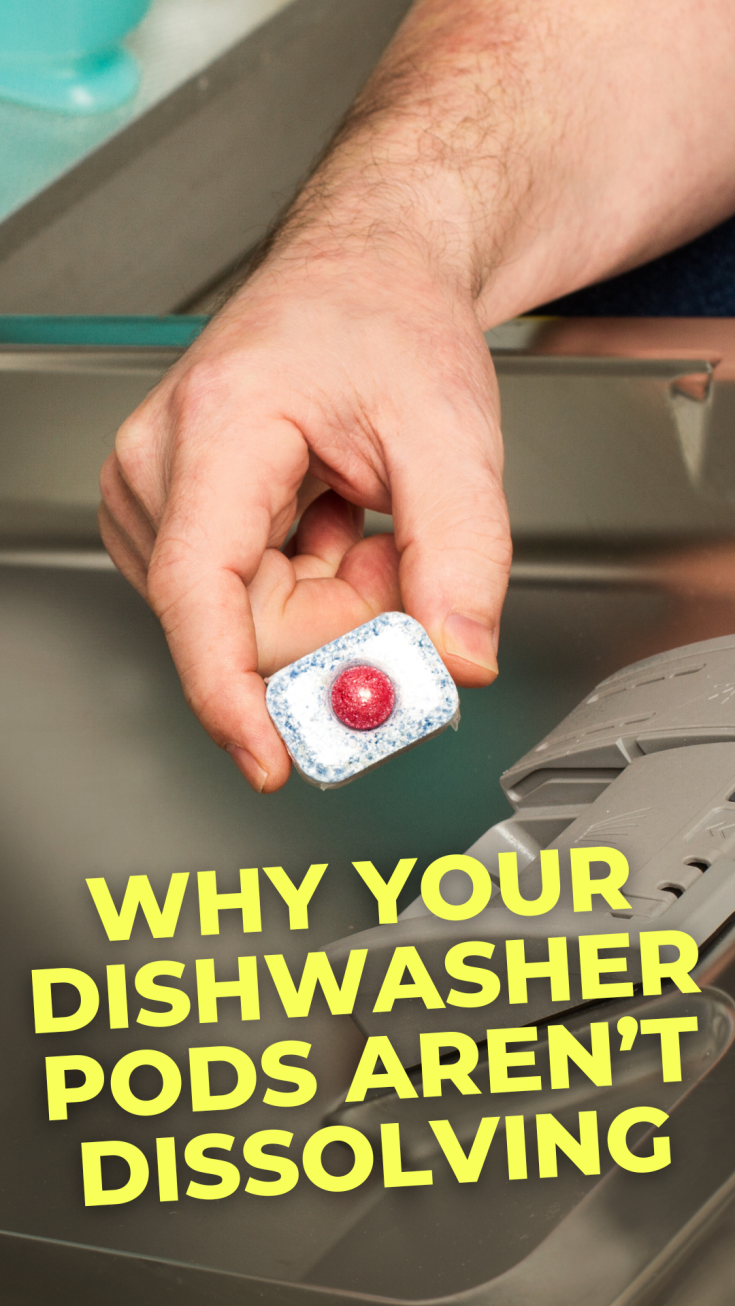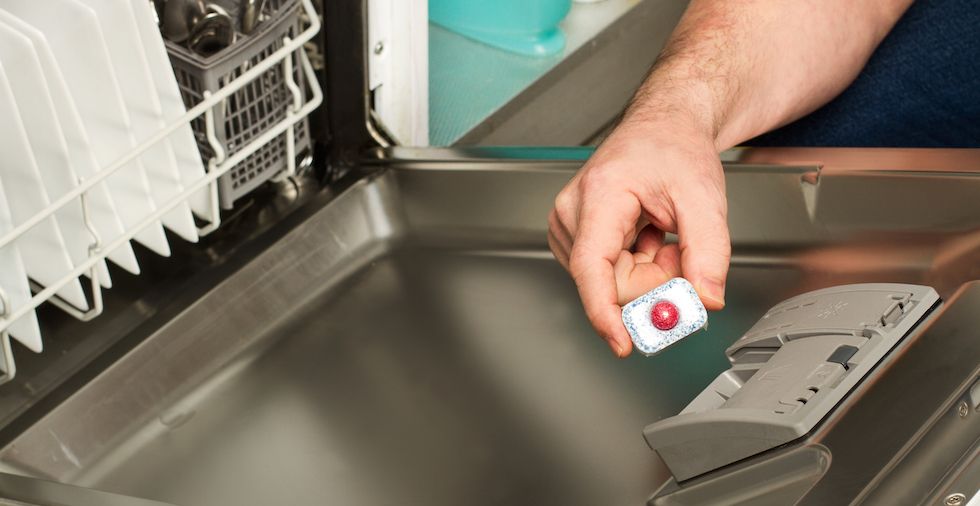- What makes dishwasher pods dissolve?
- Reasons that dishwasher pods are not dissolving
- How to make sure dishwasher pods dissolve
Dishwashers can be absolute lifesavers. They save us time and effort, ensuring our dishes emerge sparkling clean with minimal manual labour. Of course, the unsung hero here is the humble dishwasher pod. It's a crucial component in this cleaning process. Without it, you won't get the sparkle you expect when a dishwasher cycle finishes.
Yes, these convenient little packages are designed to dissolve and release detergent during the wash cycle, but what happens when they don't? You're not alone if you've ever wondered why your dishwasher pods are not dissolving. It's a simple yet important problem. In this article, we'll investigate the reasons behind this common issue and provide tips on ensuring your dishwasher pods dissolve effectively.
What makes dishwasher pods dissolve?
First, we must discuss what a dishwasher pod is and what makes it dissolve. Chances are, you've not spent much time thinking about these capsules.
Before we explore the reasons for dishwasher pods not dissolving, it's essential to understand how they are designed to work. Dishwasher pods combine detergent, rinse aid, and sometimes even degreaser. These ingredients are encased in a water-soluble film, which breaks down and releases the cleaning agents when exposed to water and heat. You know the drill here: your dishes look as clean as new.
But let's delve deeper into the steps when you use your dishwasher. The magic takes place once you press that button and shut the door. The dishwashing process typically goes like this:
- You load your dishwasher, placing the dishwasher pod in the detergent dispenser. Perhaps it has a small door that you close.
- During the wash cycle, water enters the dishwasher, and the temperature rises. This allows the water to dissolve the outer film of the pod.
- The detergent and other cleaning agents are released into the dishwasher, cleaning your dishes effectively.
Reasons that dishwasher pods are not dissolving
Okay, so that is how the process should work. However, something is going wrong if your dishwasher pods are not dissolving. Now, let's explore the reasons why your dishwasher pods may not be dissolving as they should:
1. Water temperature
One of the most common reasons for dishwasher pod failure is insufficient water temperature. Dishwasher pods require hot water to dissolve properly. If your dishwasher's water heater isn't functioning correctly or if you use a "quick wash" cycle with lower water temperatures, the pods may not dissolve completely. That can lead to residue and your dishes having a "film" on them.
2. Poor loading
Dishwasher pods must be placed in the detergent dispenser, typically on the dishwasher's door. If you simply toss the pod into the bottom of the dishwasher or the utensil basket, it may not dissolve entirely.
3. Expired pods
Like all cleaning products, dishwasher pods have a shelf life. If you've had your pods for an extended period, they may lose effectiveness. Always check the expiration date on the packaging before you use them.
4. Hard water
If you live in an area with hard water, mineral deposits can build up in your dishwasher and interfere with the dissolving process. Luckily, there's a way that you can combat this problem. Consider using a dishwasher cleaner or adding a water softener to your dishwasher to help the process.
If you're in a hard water area, chances are you're dealing with limescale, too. Learn how to remove limescale next.
5. Detergent buildup
Sometimes, remnants of previous wash cycles can accumulate in the dispenser, preventing the new pod from dissolving. Regularly clean the dispenser to avoid this pesky issue.
6. Pod placement
Make sure that nothing is blocking the detergent dispenser. Items like large plates or utensils in the lower rack could obstruct the dispenser's door, preventing the pod from being released. It's always safe to check first!
How to make sure dishwasher pods dissolve
The above section has helped you identify some problems that could be stopping your dishwasher pods from dissolving. You may find that there is a simple approach you can take to solve the problem. If you are still not sure what to do, follow these tips.
1. Use the right cycle
Select a cycle that provides sufficient water temperature and duration for the pods to dissolve. The "normal" or "auto" cycle is a safe bet.
2. Check water temperature
Check that your dishwasher's water heater is set to an appropriate temperature. It should be around 120°F (49°C) for optimal pod dissolution.
3. Proper loading
Always place the pod in the detergent dispenser. Make sure the dispenser is clean and free from any residue. Ensure you are loading your dishwasher correctly, leaving the right amount of space so that it works well.
4. Regular maintenance
Your dishwasher is also equipped with a filter to trap food particles and debris. Over time, this filter can become clogged, affecting the dishwasher's performance. Regularly remove and clean the filter to ensure proper water circulation during the wash cycle.
It might be boring, but you have to clean your dishwasher regularly. This includes the interior, spray arms, filter, and detergent dispenser. Maintenance will prevent any buildup that might hinder pod dissolution, and it can also resolve problems like your dishwasher not drying.
5. Consider rinse aid
Using a rinse aid can help improve the effectiveness of dishwasher pods by reducing water droplet formation, which can lead to streaks and spots on your dishes.
6. Deal with hard water
If hard water is an issue in your area, consider using a water softener in your dishwasher to prevent mineral buildup.
7. Cleaning the spray arms
The spray arms distribute water throughout the dishwasher. When they get clogged with mineral deposits or debris, your dishes may not get the thorough cleaning they need. Inspect the spray arms periodically and clean any blockages.
8. Consult the manual
Refer to your dishwasher's user manual for specific detergent usage and maintenance instructions. Manufacturers often provide valuable guidance, including tips like things you should never put in the dishwasher.
9. Delay start considerations
Some dishwashers have a delay start option, which can also affect pod dissolution. If your dishwasher has this feature, ensure that you're not inadvertently delaying the wash cycle, which could result in the pod sitting in the detergent dispenser for a period before the wash cycle begins.
10. Run empty cycles
Periodically, run an empty cycle with a dishwasher cleaner or a cup of white vinegar to maintain the interior's cleanliness. This can also help prevent odours from developing.
Dishwasher pods are not dissolving, which can be frustrating, but it can often be resolved with some troubleshooting. By understanding how dishwasher pods work and addressing common problems like water temperature, loading, and maintenance, you can ensure that your dishwasher consistently delivers clean, sparkling dishes.
You should always look at your user guide or manual if in doubt. Remember, a well-maintained dishwasher saves you time and helps you achieve the best possible cleaning results. So, if you've ever wondered why your dishwasher pods aren't dissolving, follow these tips to ensure a hassle-free and efficient dishwashing experience.
Next, discover things you didn't know you could clean in the dishwasher or find out how long do dishwashers last.
Q&A
Are you looking for more information on your dishwasher pods? We've got you covered. Here are some of the frequently asked questions we may have missed.
Why is my dishwasher tablet not dissolving fully?
While many factors may be at play, water temperature is one of the most common causes. You should check that your water is getting hot enough during the cycle. If not, you may find that the dishwasher pods don't dissolve or do their job.
Should I use liquid or pods?
When deciding what to use in your dishwasher, pods are more convenient than liquid. Moreover, these products are more readily available than liquid that you can use in your dishwasher.
Why is soap still in the dishwasher after the cycle?
If you find soap in your dishwasher after a cycle, it may be that your dishwasher pods are not dissolving. Check to see whether any parts of the pods are left in the bottom of the dishwasher. If you can see any residue, investigate why the dishwasher pods are not entirely dissolving. Read our guide above to find out more.
Can I put soap in the bottom of the dishwasher?
The short answer is no. If you put soap directly in the bottom of your dishwasher, it will not dissolve. You may find that this starts to bubble up during a dishwasher cycle and overflows. You should only use cleaning products designed for dishwashers in this everyday household appliance.
Are you going to try our tips? Let us know how you get on in the comments below.


Leave a Reply